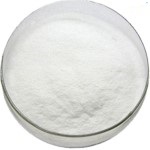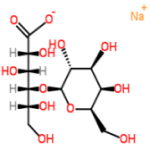CAS Number 27297-39-8, Sodium Lactobionate GMP Grade Manufacturers Exporters







CAS Number 27297-39-8, Sodium Lactobionate Manufacturer Exporter
For Properties Specifications of Sodium Lactobionate Click Properties, Specifications of Sodium Lactobionate Manufacturer.
For Uses of Sodium Lactobionate Click Uses of Sodium Lactobionate Manufacturer.
For For SDS MSDS Sheet of Sodium Lactobionate Click SDS Safety Data Sheet MSDS Sheet of Sodium Lactobionate Manufacturer.
The Properties and Specifications of Sodium Lactobionate:
General Properties and Specifications of Sodium lactobionate or Lactobionic acid sodium salt:
Description: White to pale yellow crystalline powder.
Assay: 98% to 102%
Loss on Drying: 1% maximum.
Heavy Metals: 0.003% maximum.
Storage Temperature: +20C. Shipping may be ambient.
The Uses of Sodium Lactobionate:
Sodium Lactobionate, the salt of lactobionic acid, this ingredient is a white, crystalline powder used to synthesise other chemicals. May function as a preservative in skincare. It is used in the pharmaceutical field, due its hydrating capacity of the skin, as a preventive agent for cutaneous aging. Sodium lactobionate is used as a raw material of various industries like Pharmaceutical, textile, paper, Agriculture, Food, etc,
The MSDS-SDS Hazard Statement of Sodium Lactobionate:
Sodium Lactobionate SDS, Safety Data Sheet
MSDS Sheet, Material Safety Data Sheet 25-Jan-23
Section 1: Chemical Product and Identification
Product Name & Other Names: Sodium lactobionate or Lactobionic acid sodium salt.
CAS#: 27297-39-8
EINECS EC-No.: NA
Chemical Formula: C12H21NaO12 for anhydrous C12H24NaO12-H2O for monohydrate.
Molecular Weight: 380.28 for anhydrous 398.30 for monohydrate
Relevant uses and uses advised against (if any): Laboratory and Industrial Manufacturing.
Section 2: Hazards Identification
GHS, Globally Harmonized System Classification in accordance with 29 CFR 1910
Classification according to Regulation (EC) No 1272/2008
Not a hazardous substance or mixture according to Regulation (EC) No. 1272/2008.
This substance is not classified as dangerous according to Directive 67/548/EEC.
Labeling according to GHS & Regulation (EC) No 1272/2008
GHS Label Elements NONE |
Signal Word: None
Precautionary statements:
P261: Avoid breathing dust/fume/gas/mist/vapors/spray.
P302+P352: IF ON SKIN: Wash with plenty of soap and water.
P304+P340: IF INHALED: Remove victim to fresh air and keep at rest in a position comfortable for breathing.
P305+P351+ P338: IF IN EYES: Rinse cautiously with water for several minutes. Remove contact lenses, if present and easy to do. Continue rinsing.
P337+313: If eye irritation persists get medical advice/attention.
Section 3: Composition and Information on Ingredients
Product Name & Other Names: Sodium lactobionate or Lactobionic acid sodium salt.
CAS#: 27297-39-8
Section 4: First Aid Measures
Always seek medical attention after first aid measures are provided.
Eye Contact: In case of contact, immediately flush eyes with plenty of water for at least 15 minutes. Get medical attention.
Skin Contact: In case of contact, immediately flush skin with plenty of water. Cover the irritated skin with an emollient. Thoroughly clean shoes and clothes before reuse. Get medical attention.
Inhalation: If inhaled, remove to fresh air. If not breathing, give artificial respiration. If breathing is difficult, give oxygen. Get medical attention.
Ingestion: Do NOT induce vomiting unless directed to do so by medical personnel. Never give anything by mouth to an unconscious person. If large quantities of this material are swallowed, call a physician immediately.
Section 5: Fire and Explosion Data
Flammability of the Product: It may be combustible at high temperature.
Products of Combustion: Some metallic oxides CO CO2 and fumes.
Fire Fighting Media and Instructions:
Small Fire: Use DRY chemical powder.
Large Fire: Use water spray, fog, or foam. Avoid water jet.
Special Information: In the event of a fire, wear full protective clothing and NIOSH-approved self-contained breathing apparatus with full face piece operated in the pressure demand or other positive pressure mode. At high temperatures under fire conditions, it may produce toxic or irritating fumes. Fire-extinguishing work is done from the windward and the suitable fire-extinguishing method according to the surrounding situation is used.
Section 6: Accidental Release Measures
Personal precautions, protective equipment, and emergency procedures: Ventilate area of leak or spill. Avoid breathing dust/fumes/gas/mist/vapors/spray. Use individual protective equipment (waterproof boots, suitable protective clothing, safety glasses, etc.). Do not approach facing the wind.
Environmental precautions: Do not let the product enter drains, soil, or water sources.
Methods and materials used for containment Cleanup procedures and Storage: Contain spilled material. Cover with an inert, non-combustible absorbent material, (e.g. sand, earth, diatomaceous earth, vermiculite). Vacuum or sweep-up and remove to an approved disposal container.
Section 7: Handling and Storage
Precautions for safe handling: Apply according to good manufacturing and industrial hygiene practices. Ensure proper ventilation. Wash thoroughly after handling. Do not drink, eat, or smoke while handling. Avoid contact with skin, eyes, and clothing. Minimize dust generation. Avoid breathing dust/fumes/gas/mist/vapors/spray. Keep container tightly closed. Avoid ingestion and inhalation. Use individual protective equipment (waterproof boots, suitable protective clothing, safety glasses, etc.).
Conditions for safe storage, including any incompatibilities: Store in cool, dry, and ventilated area away from heat sources and protected from sunlight in tightly closed original container. Keep air contact to a minimum. Store protected from heat, sparks and ignition sources and incompatible materials. Avoid contact with skin and eyes. Avoid inhalation of dust/mist/vapor. Do not store with incompatible materials like strong oxidizing agents. Storage Temperature: +20C. Shipping may be ambient.
Section 8: Exposure Controls/Personal Protection
Exposure Limits: Not established.
Engineering Controls: Use process enclosures, local exhaust ventilation, or other engineering controls to keep airborne levels below recommended exposure limits.
Ventilation System: A system of local and/or general exhaust is recommended to keep employee exposures as low as possible.
Personal Respirators (NIOSH Approved): For conditions of use where exposure to dust or mist is apparent and engineering controls are not feasible, a particulate respirator may be worn.
Skin Protection: Wear protective gloves and clean body-covering clothing.
Eye Protection: Use chemical safety goggles and/or full face shield where dusting or splashing of solutions is possible. Maintain eye wash fountain and quick-drench facilities in work area.
Other Control Measures: Maintain good housekeeping in work area. Handle in accordance with good industrial hygiene and safety practice.
Section 9: Physical and Chemical Properties
Physical state and appearance: White to pale yellow crystalline powder
Odor: Odorless.
Odor threshold: Not available.
pH: Not available.
Relative density: Not available.
Melting Point: Not available.
Initial boiling point and boiling range: Not available.
Flash point: Not available.
Auto-ignition temperature: Not available.
Decomposition temperature: Not available.
Upper/lower flammability or explosive limits: Not available.
Vapor pressure: Not available.
Vapor density: Not available.
Evaporation rate: Not available.
Flammability (solid, gas): Not available.
Partition coefficient: n-octanol/water: Not available.
Solubility: Insoluble in cold water, hot water. Almost insoluble in ethanol.
Viscosity: Not available.
Section 10: Stability and Reactivity Data
Stability: It is stable.
Conditions of Instability: Excessive heat, dust generation
Incompatibility with various substances: Oxidizing Agents, heat and sunlight.
Special Remarks on Reactivity: Releases water of crystallization when heated and decomposes.
Hazardous decomposition products formed under fire conditions: Carbon oxides, Sodium oxide.
Polymerization: Will not occur.
Section 11: Toxicological Information
Toxicity to Animals: Not available.
Carcinogenicity: No component of this product present at levels greater than or equal to 0.1% is identified as probable or confirmed human carcinogen by IARC, ACGIH, OSHA and NTP.
Mutagenic Effects: Not available.
Environmental Toxicity: Not available.
Section 12: Ecological Information
Ecotoxicity: Not available.
Products of Biodegradation: Possibly hazardous short-term degradation products are not likely. However, long term degradation products may arise.
Results of PBT and vPvB assessment: This substance/mixture contains no components considered to be either persistent, bioaccumulative and toxic (PBT), or very persistent and very bio accumulative (vPvB) at levels of 0.1% or higher.
Section 13: Disposal Considerations
Waste Disposal: Waste must be disposed of in accordance legal regulations.
Section 14: Transport Information
DOT USA, TDG Canada & ADR/RID Europe: Not controlled.
IMO/IMDG: Not controlled.
IATA: Not controlled.
Section 15: Other Regulatory Information
USA:
SARA 311/312 Hazard Categories: See section 2.
California Proposition 65: Not listed.
DISCLAIMER: The information and recommendations set forth herein are presented in good faith and believed correct as of the date hereof. It is compiled from various sources and it is not necessarily all inclusive nor fully adequate in every circumstance. In addition, these suggestions should not be confused with nor followed in violation of applicable laws, regulations, rules or insurance requirements applicable. This MSDS sheet is intended only as a guide to the appropriate precautionary handling of the material by a properly trained person using this product. Individuals receiving the information must exercise their independent judgment in determining its appropriateness for a particular purpose.
Anmol Chemicals & Pharmaceuticals Pvt. Ltd. is an off-shoot of Anmol Chemicals Taloja. It is located in MIDC Taloja and it is manufacturing pharmaceutical grades of API, Excepients, Food grade and Reagent grade chemicals. Anmol Chemicals & Pharmaceuticals Pvt. Ltd. is a several decades old group of companies, engaged in manufacturing, supplying, distributing, wholesale supplies for actual users, retail or small pack supplies for research and development chemicals, fine and speciality chemicals, pharmaceutical excipients, mineral fortifiers in chemically pure, Analytical reagent grade, IP BP USP Ph Eur EP JP and other pharmaceutical grade monograph including FCC Food grade chemicals and Nutraceuticals, Mineral Fortifiers at best prices.

Sodium Lactobionate Structure
CAS Number 27297-39-8, Sodium Lactobionate Manufacturer Exporter
ANMOL CHEMICALS & PHARMACEUTICALS Pvt. Ltd.
India, USA, Europe, UAE
TELEPHONE: +912223770100
Navi Mumbai, INDIA
e-mail: info(At the rate i.e. @)anmol.org
Copyright. 3-may-25
We manufacture:
Glacial Acetic Acid Manufacturer
Calcium Magnesium Lactate Gluconate
Medium-Chain Triglycerides or Caprylic Capric Triglyceride
Nebivolol Hydrochloride or Nebivolol HCl

